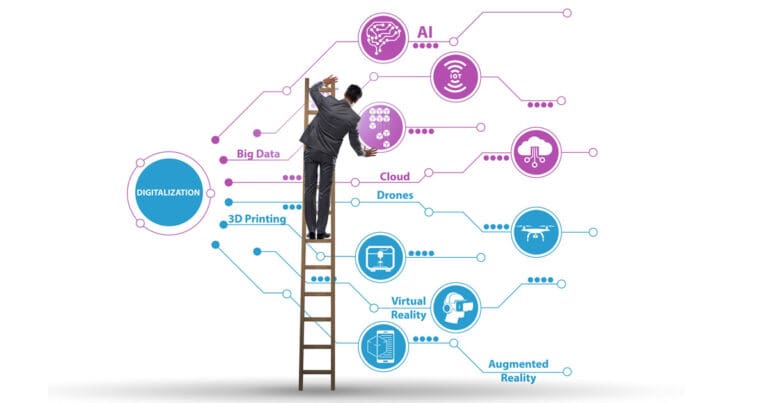Employment Trends: How to Find, Hire & Keep Top Talent

Emerging employment trends are shaping the way we find jobs and these advancements are happening faster than ever before.
To help put this unheard of, rapid evolution in perspective, the Bureau of Labor and Statistics predicts that employment will increase by 11.9 million jobs from 2020 to 2030 with an estimated $8.5 trillion shortage in talent to fill these roles driving current and future unemployment rates.
With the world of employment constantly changing, hiring managers need to stay ahead of the curve to find the best talent.
So whether you’re a hiring manager looking to stay ahead of the curve or an individual hoping to stay up-to-date on current job market trends, be sure to check out our 2023 Salary Guide.
As we look across the hiring landscape, here are some key employment trends that will be important in shaping your staffing strategies this year and beyond.

What is The Great Resignation?
The Great Resignation is the most publicized employment trend — and for good reason. The US Bureau of Labor Statistics reports that 47.8 million workers left their positions in 2021.
Reasons for quitting range from concerns over career advancement, lack of flexibility in remote work, and rethinking their skill sets.
The historic employment decline of The Great Resignation is not just reserved for 2021 and employment levels continue to suffer in 2023.
What does The Great Resignation employment trend mean for employers?
If we ever stand a chance at combating The Great Resignation, getting back to pre pandemic employment levels, and if you want to keep your best employees, you need to be competitive with your salary and benefits offerings.
You should also create a company culture that is engaging and places appropriate emphasis on employee onboarding and professional development.
Is remote work becoming more common?
With more and more companies moving to hybrid or 100% work-from-home options, organizations that fail to adapt will surely get left behind.
If you’re still feeling resistant to transitioning to a hybrid or completely remote structure, consider the fact that when polled, 61 percent of workers said they’re interested in remote work in 2022. Another 45 percent went as far as to say they would quit their current job if their employer began requiring full-time, in-person work.
What does remote work mean for employers?
If you haven’t already, it’s time to start considering a remote work policy.
This could be in the form of a partial or full-time telecommuting option, working from home one day per week, or allowing employees to pick their own hours.
As long as there is some level of flexibility, your workers will likely appreciate the efforts being made to meet them where they’re at.
The gig economy employment trend is here to stay
Freelance work is on the rise, and there’s no sign of it slowing down.
In fact, a recent report showed that by 2022, over 50 percent of the workforce will be engaged in some form of freelance work.
This shift towards the gig economy isn’t limited to a certain type of worker, either. With the rise of technology, there are new platforms and opportunities for freelancers across industries.
What does this freelance employment trend mean for employers?
Hiring freelance or contract workers is a great way to get quality talent without having to commit to a full-time employee.
It’s also a good option if you’re looking for someone with specific skills or experience that’s not readily available in your area.
Just be sure to have a contract in place that outlines the expectations and responsibilities of both parties.

Basic perks just aren’t cutting it anymore
In this highly competitive candidates’ market, free snacks, employee discounts, and special accolades like “employee of the month” simply aren’t cutting it anymore — and now that more people are working from home bringing your dog to the office has lost its luster.
Employees are becoming more savvy and well-informed and are placing greater emphasis on their physical and mental wellbeing.
They are also looking for companies that invest in their job growth as well as their personal and professional development.
What do perks & benefits mean for employers?
As we move into a post-pandemic world, employers would be wise to reevaluate their workplace benefits, post-pandemic perks, and health care benefits.
If you want to attract the best talent, it’s important to focus on creating a wide range of benefits that go beyond the basics.
Consider offering things like gym memberships, mental health days, and professional development opportunities.
How is technology influencing employment trends?
There’s no denying that technology has had a major impact on the way we live and work. The ever-increasing influence of technology, big moves to remote working, and added pressure on smaller workforces mean that more companies will look towards automation in 2022.
With new advancements in artificial intelligence, augmented reality, and automation, businesses are being forced to adapt or risk getting left behind.
What do shifts in employment technology mean for employers?
If you want to stay ahead of the curve, it’s important to start investing in automation now.
This doesn’t mean completely replacing your workforce with robots, but rather incorporating automation into certain areas of your business.
To meet that need, companies will need to turn towards organizations that provide automated services and individuals with the current, in-demand tech skills to build and manage these platforms.
This employment trend shows that the skills gap is widening
And speaking of skills, in order to stay ahead of industry trends, it’s more important than ever for companies to have a good understanding of the skills their employees need.
With the rapid pace of change, the skills gap is widening, and companies are struggling to keep up.
What does this skill gap employment trend mean for employers?
Investing in employee development and training is no longer an option and is the best and only way to close the skills gap.
By offering employees opportunities to learn new skills, you can not only improve their performance but also help them stay ahead of employment trends and help them advance their career paths.
Employment trends show a preference for soft-skills
In a world where technology is constantly evolving, the importance of soft skills has never been greater.
In 2022, companies will be looking for employees with strong interpersonal skills who are able to work collaboratively in order to meet the needs of their customers.
What does this soft-skill employment trend mean for employers?
If you want to attract and retain top talent, it’s important to focus on developing your employees’ soft skills.
This can be done through training and development programs as well as by providing opportunities for them to work collaboratively.
It’s also important to remember that not everyone learns in the same way, so employers should offer a variety of learning options including online courses, workshops, and personal mentorship.
The final word on current employment trends for 2022
In a rapidly changing world, the only way to stay ahead is to continuously adapt and evolve.
The companies that succeed in 2022 are those that are willing to embrace change and invest in their employees.
By doing so, they will be able to attract and retain the best talent.
Mondo Matches Great Talent With Great Companies
With an expansive, connected network of the top IT, Tech, Creative, and Digital Marketing professionals and a proprietary process, Mondo can match you with the hard-to-find, specialized talent you need.
- Contact Mondo today for all your hiring needs
- Download our 2022 Salary Guide for detailed salary breakdowns for roles & jobs across the technology, creative & digital marketing industries



